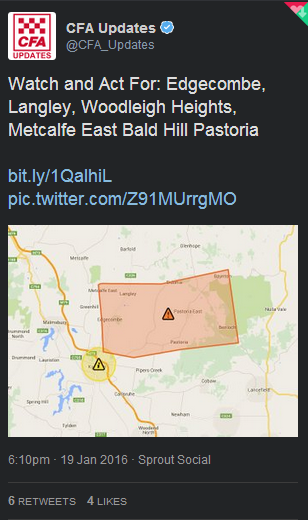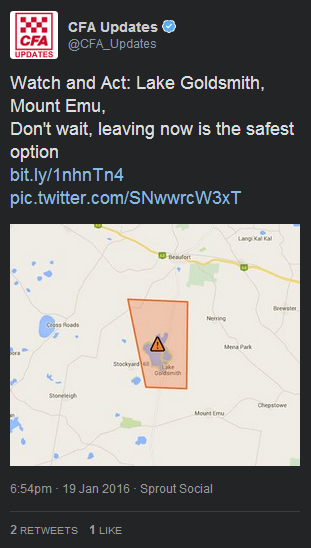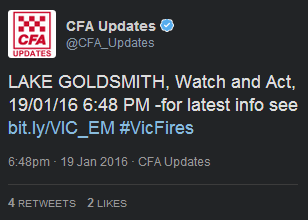What do I do about Twitter?
Twitter has begun to appear all over the place. Most people are now used to seeing tweets either embedded in mainstream media or on TV. You've probably been shaking your head for years at those silly people who keep posting links to Twitter on Facebook. You understand what a tweet looks like, and probably know the basic elements:
Let's look at these elements in detail, because they're all important:
- The picture can be attached in a variety of ways. If you use Twitter's native picture hosting service (pic.twitter.com), it will show as a preview in most Twitter clients, and as just a link in some. The great thing about using Twitter's own hosting service, is that many people get free access to Twitter on their mobile plans - and it doesn't cost anything to view the image. This is important for people with a limited monthly data allowance.
- The username is unique, of course. It will always begin with the '@' character, and you're probably used to seeing them by now.
- You may find the 'follow' button on many different websites. It is a quick and easy way to follow this user's future traffic. The user will be notified that you've followed them. Use this button generously. If they turn out to be dickheads, you can unfollow them just as easily at a later time. Don't be afraid to unfollow people who tweet stuff that drives you nuts. This will keep your timeline clean and friendly, and ensure that Twitter is an enjoyable place, not a noticeboard of people's opinions you don't agree with. I once made a poorly worded and critical tweet about the Navy, and was unfollowed by 30 people pretty much instantly. I deleted the tweet!
- The hashtag. There may be several in a tweet. Hashtags always begin with the '#' symbol. It is a way of grouping tweets together so they can be searched for easily. TV shows often suggest a hashtag to use when tweeting about their show. To search the hashtag for other tweets, just click on it. This will create a Twitter search for this hashtag, which will display all tweets that have the hashtag attached. Be wary of tweets with lots of hashtags. Such tweets are usually selling something or pushing a barrow.
- The time and date of the tweet is important. Is this an old tweet, or a new one? Sometimes tweets that are months and years old can resurface, but most tweets will be almost live; real-time. This is the most powerful feature of Twitter - that it is fully searchable in real-time. It is the best way to find out about things happening right now, and that's why Twitter is quoted so much by mainstream media.
- A 'retweet' is simply someone else tweeting a copy of a tweet to their followers. Getting a retweet always gives you a sense of achievement and value - much like having your traffic on Facebook shared. People can make a tweet a 'favourite' tweet so they can easily find it later. We'll talk more about favourites in number 9.
- Reply button. If you'd like to join the conversation, use this button to reply to the person who wrote the tweet. In this way, tweets are linked together and you can follow a conversation thread of many tweets. Twitter will display the full thread for any tweet.
- The retweet button. Retweeting a tweet will make it appear in your follower's Twitter stream. The author of the original tweet will be notified that you've retweeted their tweet to your followers. You can retweet the tweet with all its metadata intact (preferred), or you can use the RT method, which destroys the original metadata but retweets the tweet with reference to the author. Any tweet with the initials 'RT' at the beginning is a manual reweet of someone else's content. You might use the 'RT' method if you wanted to add a comment to the tweet. RT stands for 'retweet', and MT stands for 'modified tweet', indicating that you've changed it slightly from the original (perhaps to fix a typo, or remove part of the content to make room for a comment).
- The favourite button. Or 'favorite', if you're from America... Clicking on this will store the tweet in your favourites, so you can find it later. The author will be notified that you've made their tweet a favourite. This is often used just to let the author know that you like their tweet. Your favourites can be viewed by other users.
Public:
Twitter is public by default. While it possible to make a private account, this kinda defeats the purpose, because your tweets won't show up in any public searches. Your followers will be able to see them, but you will have few followers. This is not the way to use Twitter, and Facebook is better if you'd like to keep your traffic limited to family and friends. Twitter was designed to be a public forum, where everyone gets a chance to have a say. Tweets which are popular will get lots of retweets and reach many people. It is possible for a tweet to go viral, and get thousands of retweets in just 24 hours. Like anything public, there are undesirable people using Twitter for their own agendas. Maybe they are trying to sell something, or maybe they are an extremist of some kind, desperate for an audience for their rants. The group has a way of sorting these people out, and while they constantly appear, they fade away pretty fast, because everyone just ignores them and blocks their traffic. Don't be afraid to block someone on Twitter. There is no reason why you must be exposed to traffic you don't want to read.
Searchable:
It doesn't matter if you have 20, or 2,000 followers. Every tweet you make can be seen by anyone. If you make a tweet about your dog, someone searching for the term 'dog' will get your traffic. If you are in the audience of some show or function, and you tweet about it, people searching for traffic about that event will find your tweets - every one of them, as long as you tag it with the event - usually with a hashtag to make it easy for people searching. Using Twitter search is as easy as typing a word (or a hashtag) into the search box. Say you are sitting at home, and you suddenly hear sirens heading somewhere close. A Twitter search for your home town name will bring up all traffic mentioning your town or suburb. If there is an emergency in your area, the latest tweets will be about that. You'll see traffic from authorities, bystanders, and people like me who transmit emergency information on Twitter. There may be links in the tweets to further information. With this one example, you can see how Twitter search can be used to discover information regarding just about any topic you're interested in. The information will come from multiple accounts, most of which you'll never have seen before. Twitter is public.
Metadata:
There is some interesting metadata attached to your tweets. There is the time and date, of course, and the author's account name. The time is always important for emergency traffic, and tells you if a tweet is fresh, or hours old. If you allow Twitter to use your location, then the geocordinates of your location will be sent with the tweet, and this may be a privacy issue for some people. This is easily turned off, and most people keep it turned off. If you go to a football match, you might like to turn your location on to prove that you are at the match, and turn it off again later. If you keep it off, there will still be a location attached to your tweet, but it will be the location you've put in your public bio, whatever that may be. If the tweet is a reply to another tweet, then a link to the original tweet will be included in the metadata to preserve the conversation thread.
Making an account:
The only thing you need to make a Twitter account is an email address. Your email address will not be displayed publicly, and no other user can find your email address through Twitter. Every individual account must have its own individual email address. To make an account, go to
https://twitter.com/ - and follow the prompts. It only takes a moment.
Why use it?
Because you can reach people you never dreamed of reaching. A person with 2,000 followers carries a lot of political clout. But it's a two-edged sword, as having a lot of followers means being unable to please everyone. Since you are constrained to 140 characters (less if you want to include a picture or a link), your grammar skills improve as you begin to craft tweets that make sense in so few characters. The restriction forces you to be clear and precise and not waste a single word. Adjectives are the first things to get tossed out to make space, so your writing skills will improve, and you'll find yourself looking for that perfect word to describe something! You will grow to be proud of the tweets you craft.
I'd like to show you an example of one small thing I achieved in the last 24hrs just using Twitter. Like the rest of the world, I've been very upset by Robin Williams' tragic death, and I got to thinking about the pressure celebrities are under to deliver, all the time, especially artists. So I thought about it, and I narrowed down my list of much-loved celebs until I was left with just one - my all-time favourite author, Raymond E Feist. Now, I happen to know that Raymond uses Twitter, so I sent him this tweet:
Notice the link in this tweet. It is actually a link to another tweet!
I didn't have any ideas of my solitary voice saving Raymond's life in any way, but I wanted to let him know that people had started to think about their favourite celebs during this difficult time for us all. Incredibly, I received a reply this morning:
Twitter works. It's been working for me since 2009, and because I'm so passionate about it, I've copped my fair share of ribbing. But now I have people in high places asking me for help to become Twitter-savvy. I've been paid for some of this work, but mostly I do it for free, to help Victorians deal with the onset of wildfire (my passion). People who find things out in real-time via Twitter are proud that they've been able to find out about something few other people know about yet. They are the people that are always the first to tell you about some disaster in another country, or just around the corner, so in reality, Twitter reaches many other people who don't even use it. Latest developments in any issue is always the hot gossip around the water-cooler, or with friends at a social function. Like some people are hooked on Facebook, there are a lot of people addicted to Twitter, who won't get their noses out of their phones long enough to talk to anyone else. There are extremes in every area of society.
I propose that you think of Twitter as 'another source of information', even if you never make a tweet. In the event of emergency, always dial '000' in Australia and report it so crews can begin to respond, before you begin tweeting about it, tempting though it may be.
Brad Lemon
16th August, 2014.







